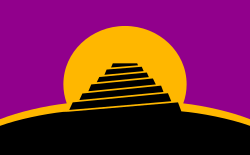Portal:Constructed languages
Introduction

A constructed language is a language for communication between humans (i.e. not with or between computers) but unlike a language that emerges from human interaction, is intentionally devised for a particular purpose. Constructed language is often shortened to conlang, cloŋ, and even ŋ and is a relatively broad term that encompasses subcategories including: fictional, artificial, engineered, planned and invented. A constructed language may include natural language aspects including phonology, grammar, orthography, and vocabulary. Interlinguistics includes the study of constructed languages. (Full article...)
Selected language

Toki Pona is an oligoisolating constructed language, created by Canadian linguist and translator Sonja Lang as a philosophical language for the purpose of simplifying thoughts and communication. It was first published online in 2001 as a draft, and later in complete form in the book, Toki Pona: The Language of Good, in 2014. A small community of speakers developed in the early 2000s, and has continued to grow larger over the years, especially after the release of the official book. While, activity mostly takes place online in chat rooms, on social media, and in other groups, there have been a few organized in-person meetings in recent years.
The underlying feature of Toki Pona is minimalism. It focuses on simple universal concepts, making use of very little to express the most. The language has 120–125 root words and 14 phonemes that are easy to pronounce across different languages. Although not initially intended as an international auxiliary language, it may function as one. Inspired by Taoist philosophy, the language is designed to help users concentrate on basic things and to promote positive thinking, in accordance with the Sapir–Whorf hypothesis. Despite the small vocabulary, speakers are able to understand and communicate with each other, mainly relying on context and combinations of several words to express more specific meanings. Find out more...
Did you know...
...that Volapük, a constructed language which once attracted thousands, now has, at most, 30 speakers?
...that Volapük nevertheless has its own Wikipedia, the Vükiped?
...that during the mid 19th century The Church of Jesus Christ of Latter-day Saints briefly advocated the use by its members of the Deseret alphabet in place of the Latin one?
Current events
(none)
Corresponding categories
Projects

|
You are invited to participate in WikiProject Constructed languages, a WikiProject dedicated to developing and improving articles about constructed languages. |
Things you can do
-
Join: Constructed Languages WikiProject & add {{Wikipedia:WikiProject Constructed languages/Userbox}}
Follow: Recent changes in related articles
Tag: {{WP conlangs}}, {{Constructed languages}}, and {{Infobox language}} (see WP:CL Templates)
Evaluate: Everything in Category:Unassessed constructed language articles
Report: Edit wars and deletions
Expand: everything in category:Constructed language stubs
Requests:
-
Abakwi, Ancient Language, Arovën, Baza, Bluddian, Dremlang, Eaiea, Eloi, Ekspreso, Esperando, Fasile, Glide, Herman Miller, Language Creation Society, Latejami, Mezhdunarodny Nauchny Yazyk, Mirad, Modern Indo-European, Mondlango, Musbrek, Noxilo, Or'zet, Romanica (rd), Romanova (rd), Signuno, Sperethiel, Szkev, Tceqli/Ceqli, Thosk, Tokcir, Troscann, Unas, UNI, Universalspråket, Vorlin.
Web resources

Some Internet resources relating to constructed languages, by Richard Kennaway
UniLang.org
Conlang wiki
Articles
Wikipedia in constructed languages
Associated Wikimedia
The following Wikimedia Foundation sister projects provide more on this subject:
-
Commons
Free media repository -
Wikibooks
Free textbooks and manuals -
Wikidata
Free knowledge base -
Wikinews
Free-content news -
Wikiquote
Collection of quotations -
Wikisource
Free-content library -
Wikiversity
Free learning tools -
Wiktionary
Dictionary and thesaurus














